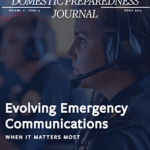In the years and months after the 11 September attacks, a great deal of work has been done at the federal level both to improve overall domestic preparedness and to standardize the response methods prescribed to deal with major disasters. Homeland Security Presidential Directives (HSPDs) 5 & 8 directed the work through development and issuance of a National Response Plan (NRP) and creation of the National Incident Management System (NIMS). The latter formally specifies use of the Incident Command System (ICS) as the standard approach to managing major disasters and catastrophes. The same directives mandate various training programs that are required.
As a result of the actions taken after 11 September, the nation is now better prepared to handle a disaster than it was on that day. Some might look at the difficulties encountered during Hurricanes Katrina and Rita and disagree with that assessment. However, as with so many other issues in the real world of emergency management, the truth is more complicated than it might seem from reading the papers or watching the evening news on television.
On 11 September 2001, long lines of ambulances swarmed into lower Manhattan. Many of them were from emergency fleets; others came from non-emergency providers. They came from nearby cities and states, and from as far away as Canada. What they shared was a willingness to help in that national moment of tragedy. What they did not share was a common training background.
Forced Evacuations Sometimes Required
One of the most important issues related to the consequence-management problems that were so obvious in the wake of the two hurricanes was the inability – of almost all of the state, local, and federal agencies involved – to quickly and fully evacuate more of the people immediately affected. Of even greater concern was the inability to evacuate the patients in care facilities such as hospitals and nursing homes.
Many states – Louisiana and Texas among them – require nursing homes to have formulated, and to be ready to execute, an emergency plan that includes forced evacuation. Unfortunately, there are often no individuals or government agencies available and/or specifically responsible for reviewing those plans, and there is seldom if ever a realistic program in place to carry out training drills and exercises.
Further, and possibly of even greater importance, there usually is no central authority designated to ensure that the same personnel and material resources that would be required for an effective evacuation are not listed in several different plans. Nor, in most jurisdictions, is there any individual or agency designated to take requests for and control the allocation of resources during an emergency. Moreover, when and where an individual or agency has been designated, the process for requesting resources is not widely known outside of the emergency-management community. The end result, of course, is that evacuations such as the transfer of patients from nursing homes in some areas in Texas – carried out in anticipation of Hurricane Rita – were often carried out by ad-hoc “get it done” methods and resources.
Too Much and Too Soon
What frequently happens is that well-intentioned bus or ambulance companies enter into agreements with state and local governments to provide evacuation services for nursing homes. Unfortunately, the companies involved often agree to provide the same services to many facilities, a practice that might be acceptable in situations affecting only one or a few facilities. In mass disasters affecting an entire state or a major region within the state – and, therefore, a large number of facilities all at the same time – the result is an impossible situation in which a single resource is being relied on for multiple evacuations to be carried out simultaneously.
The natural inclination would be to criticize the bus and ambulance companies involved. It should be remembered, though, that most evacuation planning anticipates and is based on facility-specific events such as a fire, a flood, or the loss of heat – with other facilities in the same general area remaining unaffected. It is in responding to regional events and incidents, in which the general evacuation of a large area within a state is required, that these arrangements become problematic. The need for much greater coordination of both tasks and resources is the key to resolving this problem, but to be effective that coordination has to start during the planning phase.
In planning for evacuations, it is essential that every resource reasonably available that might be used is considered. The place to start is with: (a) the resource providers – i.e., the bus and ambulance companies working in a specific geographic area; and (b) the hospitals, nursing homes, and other facilities in the same area that might need the resources. Estimates of the resources needed to evacuate a specific facility must be created, and these estimates should be based on the number of beds in the facility, rather than on the current patient population. The transportation resources likely to be available also must be estimated, keeping in mind the probability that some will be out of service due to lack of staffing and/or vehicle breakdowns.
The same factors apply when staffing is considered. Often, the same person who is a member of the local volunteer ambulance corps may be working as a nurse in the local emergency room and/or is a member of the regional Disaster Medical Assistance Team (DMAT) as well. That one person might well be counted three times, therefore, when staffing estimates are developed.
The first and most obvious solution is to centralize at least some of the resource management required to cope with major incidents. It is impossible to achieve effective resource management of a large regional event when each facility in the region is free to negotiate separately with the resource providers available. Here the rule of thumb should be that, when the magnitude of an event is greater than can be managed at the local level, the responsibility for coordination must be assigned to a higher level. This is probably the only way that coordination not only can be effective but also can prevent a competition for resources.
An Ethical and Legitimate Contract
All of which is not to suggest that the management of the facilities affected should be absolved of planning responsibilities. However, the planning efforts of the facility should be focused on facility-specific events and those that are likely to be only local in scope. A fire at the facility that requires moving the clients to a sister facility, for example, would be well within the scope of the facility’s plan. It also is likely to be the highest magnitude of event for which the contracted resource provider might legitimately, and ethically, contract with a number of different facilities without running into the need to prioritize limited resources in an ad hoc manner.
One of the keys to responding to major disasters is thinking outside the box in terms of resource planning. The example of a nursing home evacuation in the context of a general evacuation of the surrounding region, including other nursing homes and similar facilities, could be used to illustrate this point.
In an evacuation such as that postulated, ambulances would be needed to evacuate the sickest and the most fragile patients, because ambulances have both the equipment needed to transport patients on stretchers and the trained personnel and equipment also required to provide care during the transportation phase of an evacuation.
Here it should be noted that, although differences in the level of care provided by the crew of an ambulance are a common way of typing ambulances, for this discussion the distinction between emergency and non-emergency ambulances is a more important consideration. This division is based on whether or not the ambulance is used to answer emergency 9-1-1 calls. Many ambulances are available only for answering emergency calls; others never respond to emergency calls but are used instead to transfer patients between care facilities and/or from medical facilities to the patients’ homes.
In many states, an emergency ambulance is given that designation in terms of the staffing, training, and equipment requirements mandated. What separates the two types of ambulances is usually the comparative experience of the crew members. In many respects the crews of the non-emergency transport ambulances have a broader base of experience to operate in an evacuation. This is because their stock in trade is transporting a very sick patient what is sometimes a long distance. Where they are often at a disadvantage is in terms of their specific ICS-related experience.
A Temporary Solution, But No Clear Mandate
There are other transportation resources that routinely carry people to and fro who do not need care en route – wheelchair vans, for example, or Para transits, as they are called in many states, or ambulettes. In New York State, these vehicles are regulated by the Department of Motor Vehicle and are considered a specialized type of bus rather than an extension of medical care. For disaster-planning purposes, though, they must be considered to be vehicles that are capable of transporting a wheelchair but not a stretcher, and that provide no medical care during transport. Among the other general (but non-medical) transportation resources available in times of disaster would be mass-transit buses and vans.
All of these non-medical transportation resources share certain similarities, but they do not normally respond to an emergency, and their “staffs” – the individual drivers, in most cases – are trained to carry out only the tasks they are normally assigned. What is lacking, in most cases, is an organized plan to train them for operations under a management structure that would be responsible for evacuations during a disaster.
ICS is building what is essentially a temporary management structure that can be used in responding to a specific incident. For even that temporary structure to work, though, all of the players involved must be working from the same plan. Non-emergency ambulance staff, para-transit and/or bus drivers, and their management personnel and dispatchers, all must be aware, therefore, of their respective roles within the ICS structure, and should be thoroughly familiar with the plans they may be involved in.
It will do no good for any agency to be assigned regional centralized resource-management authority if the human components of those resources do not understand the plan. This need for understanding extends throughout the community. The good news is that the training resources needed are largely in place. What is still lacking are clear mandates from local, state, and federal decision makers.

Joseph Cahill
Joseph Cahill is the director of medicolegal investigations for the Massachusetts Office of the Chief Medical Examiner. He previously served as exercise and training coordinator for the Massachusetts Department of Public Health and as emergency planner in the Westchester County (N.Y.) Office of Emergency Management. He also served for five years as citywide advanced life support (ALS) coordinator for the FDNY – Bureau of EMS. Before that, he was the department’s Division 6 ALS coordinator, covering the South Bronx and Harlem. He also served on the faculty of the Westchester County Community College’s paramedic program and has been a frequent guest lecturer for the U.S. Secret Service, the FDNY EMS Academy, and Montefiore Hospital.
- Joseph Cahillhttps://domesticpreparedness.com/author/joseph-cahill
- Joseph Cahillhttps://domesticpreparedness.com/author/joseph-cahill
- Joseph Cahillhttps://domesticpreparedness.com/author/joseph-cahill
- Joseph Cahillhttps://domesticpreparedness.com/author/joseph-cahill






